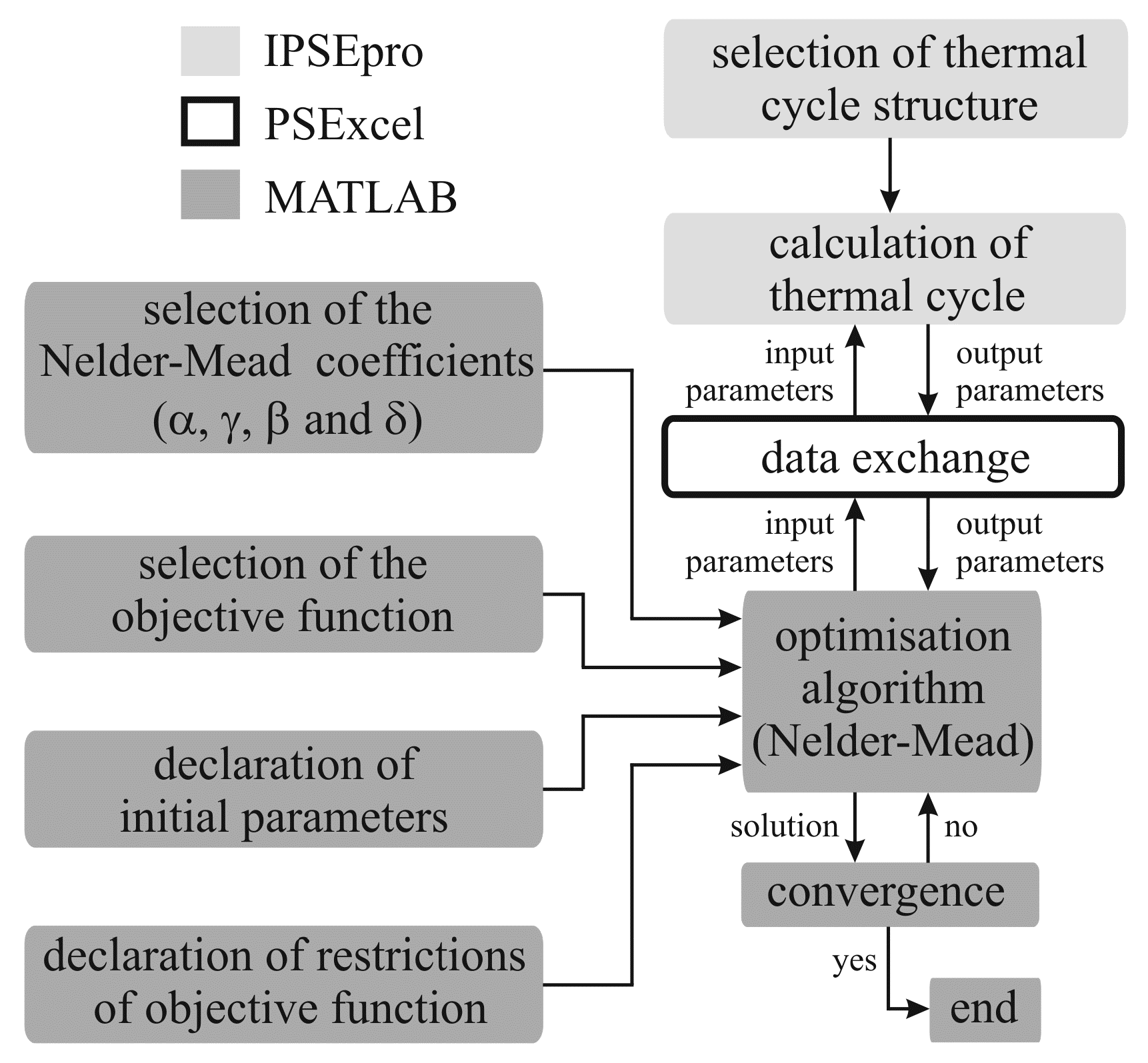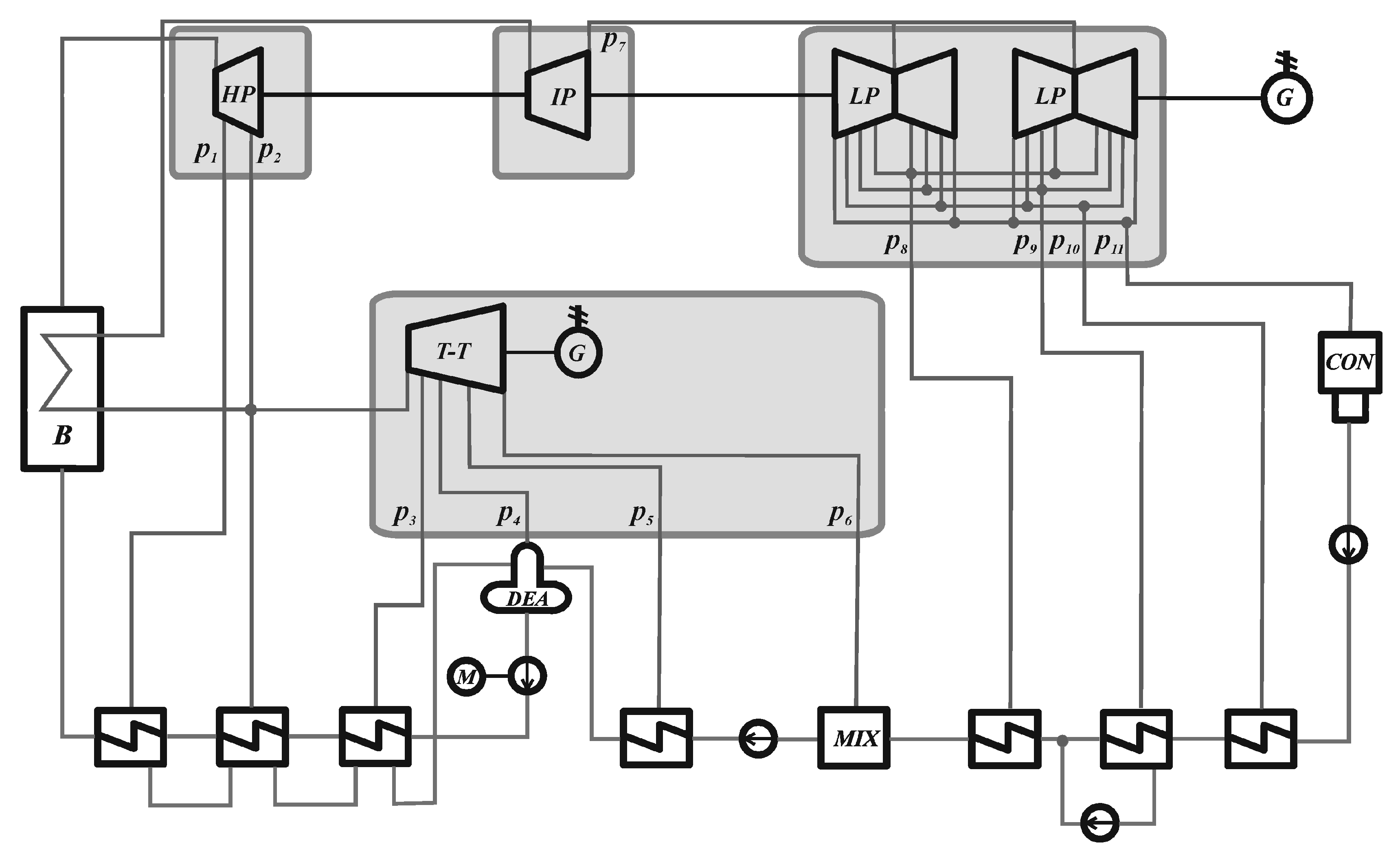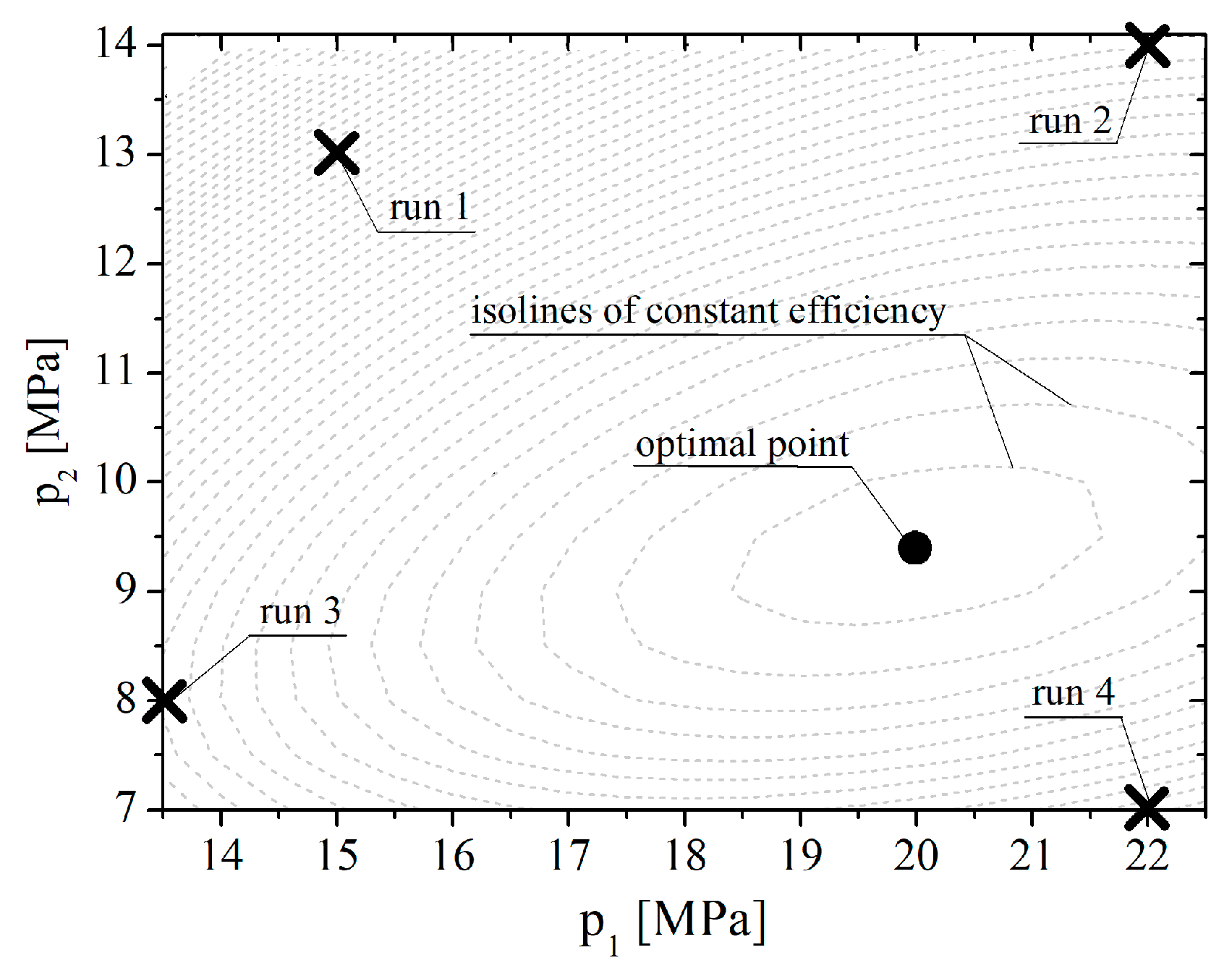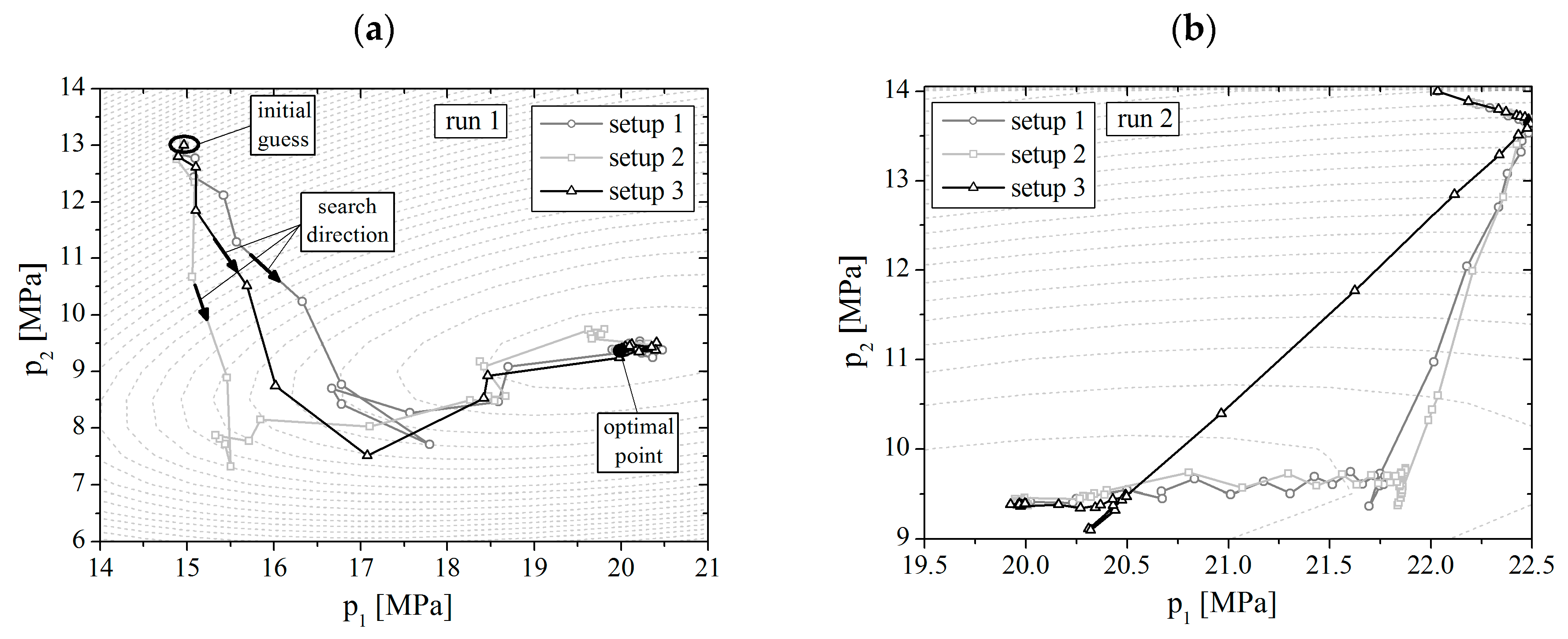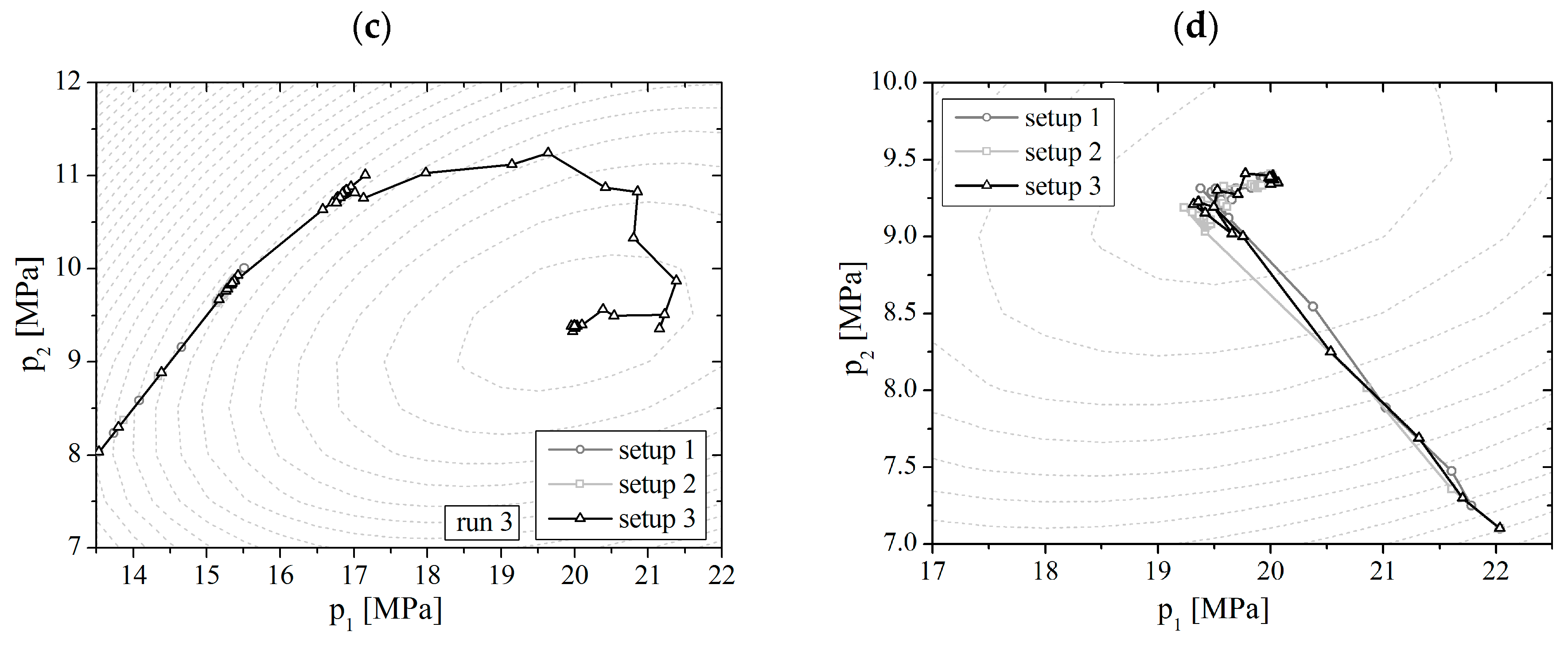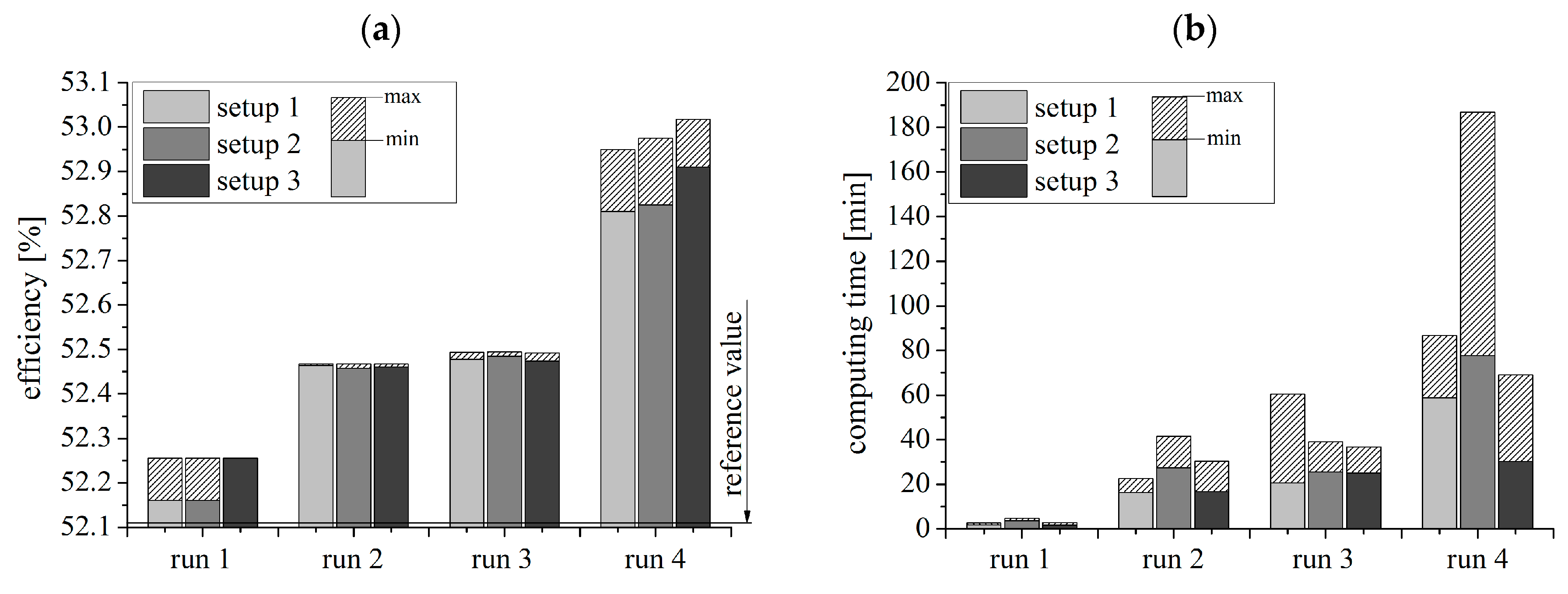1. Introduction
During the last few decades, huge progress in energy production with the use of coal fired power plants (PP) has been observed. Such improvements have been achieved by increasing live steam parameters, i.e., pressure and temperature. Standard subcritical power plants operating with live steam temperatures of up to 550 °C and pressures within the range between 16 and 17 MPa have allowed for electricity conversion with an efficiency of 38% [
1], while the introduction of supercritical conditions, a steam temperature of 600 °C and a pressure of 22–24 MPa has allowed an increase in the PP efficiency up to 45% [
2]. The further development of such technology towards even greater ultra-supercritical conditions, with steam temperatures of up to 650 °C and pressures even higher than 26 MPa have allowed the generation of electricity with an efficiency approaching 50% [
3,
4].
Today, the power plant industry is still facing continued technology development aimed at introducing even greater live steam parameters, classified as advanced ultra-supercritical conditions (A-USC), with temperatures of 700/720 °C and pressures of about 35 MPa, which should ensure the achievement of PP efficiencies even higher than 52% [
5].
The implementation of A-USC conditions extorts the development of subsequent PP elements—for example, new steam turbines [
6,
7] and high performance boilers [
8]—and the implementation of alternative technical solutions, such as boilers equipped with fluidised beds [
9,
10,
11]. An increase in live steam conditions cannot be achieved without intervening in the structure of a thermal cycle or without the changing of local parameters. As a consequence, a number of PP configurations have been introduced, i.e., those with a single reheat [
12], those with a double reheat [
13], those with a regenerative—also called tuning—turbine [
14], and solutions utilising waste heat to improve PP efficiency [
15]. The development of such technology also presents a number of challenges in the development of even more advanced combined gas-steam cycles [
16,
17].
Currently, government regulations, especially in European countries, give attention to the reduction of greenhouse gasses, mainly of CO
2. In turn, newly designed installations have been developed, such as integrated gasification combined cycle (IGCC) [
18] and carbon capture units coupled with power plants [
19], which enhance the complexity of thermal cycles’ structures and make the finding of optimal working conditions a problematic issue.
Thus, the very complex structure of PP, accompanied by a multitude of partial processes and a variety of thermal cycle variants, means that the development of efficient numerical tools allowing to search for the optimal configuration of each PP thermal cycle is strongly recommended. A promising solution may be the coupling of mathematical modelling together with optimisation algorithms. It should be noted, however, that the complex PP contains a considerable number of units, which makes the optimisation task exceptionally difficult.
The available literature offers a variety of optimisation heuristics, which can be generally classified into two groups, i.e., gradient-based and direct search (DS) approaches [
20,
21]. The former require the information concerning not only the objective function but also the gradient (partial derivatives). In this approach, the objective function must be differentiable within the entire computational domain [
22]. DS optimisation methods search for the optimum solely based on the objective function. On the one hand, when the objective function can be easily differentiated, derivative-based approaches are much more effective than DS methods, as the convergence is reached much faster. On the other hand, in a number of practical applications, the estimation of the gradient may require substantial computational effort, consequently leading to a decrease in the efficiency of such method types. In turn, the application of DS approaches is usually more convenient [
23].
Optimising a PP, which is very complex, and where non-linear interactions exist between parameters, it is essential to have the possibility of a flexible formulation of the optimisation task and the constraints. Today, many of commercially available software packages include their own optimisation tools. However, in most cases, the constraint function is given as an explicit formula, so the application of these tools in practice is strongly limited. Thus, as the source literature reveals, authors usually focus on the development of their own in-house algorithms [
24,
25,
26,
27].
A variety of strategies related to the optimisation of power plants can be found. The most frequently used are Genetic Algorithm (GA) [
28,
29] and the methods involving soft-computing [
30,
31]. Some works can be found also utilising other optimisation techniques such as Monte Carlo simulations [
32], the sequential quadratic programming method [
33], particle swarm optimisation [
34,
35], methods allowing the yielding of a set of Pareto frontiers, multi-objective optimisation [
36] and the optimisation procedures available in the MATLAB Optimization Toolbox [
37].
Only a few works are devoted to the application of DS methods in the optimisation of thermal cycles. For instance, in one work [
38], a coupling between a complex mathematical model of a combined power plant and the Rosenbrock algorithm was performed to find the best thermal cycle configuration. In another work [
39], the Nelder-Mead (NM) approach was used to optimise 900 MW PP working with A-UCS conditions. In one of the most recent papers [
40], the usefulness of three different DS methods, i.e., NM, Rosenbrock and Hooke-Jeeves, in the optimisation of A-UCS PP was examined. The last work revealed a huge potential of these approaches in the optimisation of complex thermal cycles.
The present work was about numerical modelling and the DS optimisation of conceptual advanced ultra-supercritical (A-USC) PP with the use of a software package including IPSEpro and MATLAB. The NM simplex based algorithm was used for the optimisation purpose. The NM approach was selected due to several reasons:
It is a widely used DS method for solving the unconstrained optimisation problem and it is very easy to implement in practice [
23,
41],
Its usefulness in the optimisation of A-USC PP has already been found, however, it was found that even when the position of the initial simplex is changed monotonously, the paths in the decision space can substantially change, leading to non-monotonous variations in computation time (CT) [
40].
The latter reason constitutes the primary motivation for the present study, which is, concomitantly, the continuation of the work already undertaken in [
40]. The sensitivity of the NM algorithm to the choice of initial points may noticeably influence the computing time, particularly when a large number of decision variables is concerned. Such inconvenience has already been recognised in a number of research works, and much effort has been put to finding the best solution for this problem. For instance, in the work [
42], authors conducted a sensitivity study with the use of a selected set of test cases, which consequently allowed the determination of the best values of the NM coefficients leading to the largest number of successes in the minimisation procedure. Begambre and Laier [
43] combined the Particle Swarm Optimisation with the NM simplex approach in order to utilise the benefits of each method, and developed a more stable hybrid approach. Wang and Shoup [
44] continued the study already performed in [
42] to better understand the NM parameters’ impact on algorithm behaviour. The comprehensive parameter sensitivity study was performed using seven different mathematical functions. This test showed important relations between the NM Simplex parameters (i.e., reflection, expansion, contraction and simplex size) and the optimal solutions. Moreover, the authors proposed a different set of NM parameters than those pointed out in the work [
42].
The major aim of the present work was to demonstrate the capability of software packages including IPSEpro, MATLAB and MS Excel in the optimisation process of a complex power plant, as well as to analyse the impact of three different NM configurations on the optimisation of A-USC PP. In particular, the original set of NM parameters was compared with the sets of coefficients proposed in works [
42] and [
44], collected in
Table 1 and denoted further within the paper as setup 1, setup 2 and setup 3.
In order to introduce an additional novel element with respect to the work [
40], the impact of different sets of decision variables—i.e., all of the bleed and outlet pressures from each turbine on the objective function (i.e., the PP efficiency)—was examined.
5. Conclusions
This work demonstrates how IPSEpro, MATLAB and MS Excel can be effectively combined for the optimisation process for complex power plants. The NM algorithm was employed as one of the most frequently used direct search approaches. Particular attention was devoted to the studying of different NM operating coefficients, i.e., reflection, expansion, contraction and simplex size. Three different sets of NM coefficients were investigated, all adopted from the available literature (a standard NM setup, the setup of Fan and Zahara [
42] and the setup proposed by Wang and Shoup [
44]). The selection of the most suitable NM configuration (among these offered in the literature) was performed based on both CT and the capability of the algorithm in finding the PP configuration ensuring an efficiency rise.
Where a small number of decision variables was concerned (pressures
p1 and
p2), no difference between the three investigated configurations was observed; however, the standard setup and the one proposed by Fan and Zahara [
42] failed in finding optimal solutions in one out of four investigated simplex configurations.
When a greater number of decision variables was taken into account, the setup of Wang and Shoup [
44] allowed finding the PP configuration with the highest efficiency. Moreover, the variation of the optimised objective function was the smallest, regardless of simplex configurations. It was also found that the CT required to reach a convergent solution for this NM configuration is the shortest of those from the three investigated algorithm setups. This observation shows that this configuration, tested previously on seven simple test functions, also works well with a complex optimisation task and can be recommended as the most advisable one (among the ones available in the literature).
Finally, the optimisation procedure allowed achieving a total increase of efficiency equal to 0.9 percentage points compared with the reference value, and this should be regarded as a substantial improvement, proving that the proposed integrated numerical package is a useful and effective tool in the optimisation of complex thermal cycles.
